At a time when tensions between North Korea and the United States are a high, Pyongyang has detained an American soldier, who crossed the heavily fortified border from South Korea without permission. Identified as Private 2nd Class Travis King, he becomes the first American in nearly five years to be detained by North Korea for crossing the demilitarised zone (DMZ) that separates the country from South Korea. King, as per an Associated Press report, had served nearly two months in a South Korean prison on assault charges. He was released on 10 July after serving his time and was being sent home to Fort Bliss, Texas, on Monday, where he could have faced additional military disciplinary actions and discharge from the service. According to officials, 32-year-old King was taken to the airport and escorted as far as customs. But instead of getting on the plane, he left the airport and later joined a tour of the Korean border village of Panmunjom. He bolted across the border, which is lined with guards and often crowded with tourists, on Tuesday afternoon local time in Korea. According to a report by CBS News, the soldier gave out a loud ‘ha ha ha,’ and just ran in between some buildings. America’s defense secretary Lloyd Austin confirmed that a service member was likely now in North Korean custody. “We’re closely monitoring and investigating the situation,” Austin told the media in Washington. Here’s a better look at the area where the soldier was reportedly detained from and its history. The DMZ, explained The Demilitarised Zone (DMZ) is a buffer zone between North and South Korea. It was established in 1953 as part of the Korean Armistice Agreement between the United Nations, North Korea, and China to end the Korean War. It is 248 kilometres (154 miles) long and four kilometres (2.5 miles) wide and interestingly, Seoul – the capital of South Korea – lies only 60 km away from here. [caption id=“attachment_12885722” align=“alignnone” width=“640”] Graphic: Pranay Bhardwaj[/caption] Inside this area, neither country can fire weapons, build up military personnel or equipment, or start any act of aggression. However, along either side of the border is a different story; it is heavily fortified, with some even calling it ‘the scariest place on Earth’. The area is entirely marked with barbed wire fencing and is littered with scores of mines, making it probably the most difficult place to pass. It also has several watch stations patrolling soldiers along its entire length. Notably, the DMZ has become an unexpected wildlife sanctuary. According to South Korea’s National Institute of Ecology, almost 6,200 wildlife species now call the DMZ home. In particular, 38 per cent of the endangered species of the Korean peninsula live in the zone. These include golden eagles, musk deer, and mountain goats, among others. [caption id=“attachment_12885842” align=“alignnone” width=“640”]
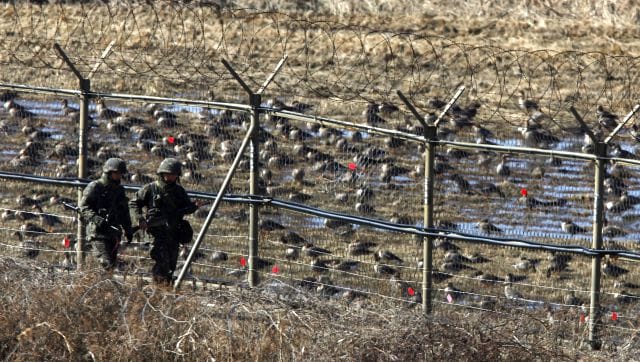 South Korean soldiers walk past birds as they patrol along a barbed-wire fence near the demilitarized zone (DMZ), which separates the two Koreas, in Paju, north of Seoul. File image/Reuters[/caption] Truce village of Panmunjom Inside the DMZ lies the Joint Security Area (JSA), which houses the so-called peace village of Panmunjom, where the armistice was signed in 1953. Known for its blue huts, this village draws visitors from both sides who want to see the Cold War’s last frontier. Every year, hundreds of thousands of people visit the Joint Security Area for a chance to see North Korean soldiers standing at attention just dozens of feet away. They are made to sign UNC REG 551-1, which states, “The visit to the Joint Security Area at Panmunjom will entail entry into a hostile area and possibility of injury or death as a direct result of enemy action.” [caption id=“attachment_12885872” align=“alignnone” width=“640”]
South Korean soldiers walk past birds as they patrol along a barbed-wire fence near the demilitarized zone (DMZ), which separates the two Koreas, in Paju, north of Seoul. File image/Reuters[/caption] Truce village of Panmunjom Inside the DMZ lies the Joint Security Area (JSA), which houses the so-called peace village of Panmunjom, where the armistice was signed in 1953. Known for its blue huts, this village draws visitors from both sides who want to see the Cold War’s last frontier. Every year, hundreds of thousands of people visit the Joint Security Area for a chance to see North Korean soldiers standing at attention just dozens of feet away. They are made to sign UNC REG 551-1, which states, “The visit to the Joint Security Area at Panmunjom will entail entry into a hostile area and possibility of injury or death as a direct result of enemy action.” [caption id=“attachment_12885872” align=“alignnone” width=“640”]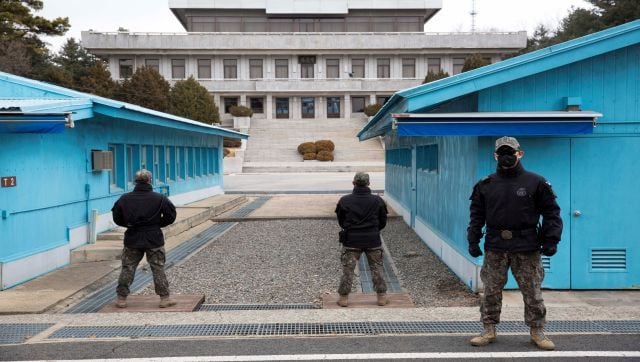 South Korean soldiers stand guard the Joint Security Area (JSA) on the Demilitarised Zone (DMZ) in the border village of Panmunjom in Paju, South Korea. Reuters[/caption] In 2018, South Korea also launched “DMZ peace trails” to the public, with the then second Vice Minister of Tourism Cho Yong-man saying, “Now is the “time to overcome the situation of division.” The peace trails allow visitors to walk and explore areas where nature has thrived in the absence of people, including in Ganghwa County, a group of islands that border North Korea and lie just 45 km (28 miles) from the South Korean capital Seoul. Action along the DMZ The American soldier crossing the DMZ is not a lone incident. The buffer zone has seen some skirmishes and violence in the past. In fact, as USAToday reports, it has been the site of several dramatic events over the decades since the war ended with a truce but not a peace agreement. One of the first instances of an American crossing the DMZ was in 1965. Born in Rich Square, North Carolina, Charles Jenkins was one of the few Cold War-era US soldiers who fled to North Korea while serving in the South. He deserted his post and fled across the Demilitarised Zone separating the two Koreas. North Korea treated Jenkins as a propaganda asset, showcasing him in leaflets and films. In 1980, Jenkins married 21-year-old Hitomi Soga, a Japanese nursing student who had been abducted by North Korean agents in 1978. Soga was allowed to return to Japan in 2002. In 2004, Jenkins was allowed to leave North Korea and rejoin his wife in Japan, where he surrendered to the US military authorities and faced charges that he abandoned his unit and defected to North Korea. He was dishonourably discharged and sentenced to 25 days in a US military jail in Japan. He died in Japan in 2017. [caption id=“attachment_12885922” align=“alignnone” width=“640”]
South Korean soldiers stand guard the Joint Security Area (JSA) on the Demilitarised Zone (DMZ) in the border village of Panmunjom in Paju, South Korea. Reuters[/caption] In 2018, South Korea also launched “DMZ peace trails” to the public, with the then second Vice Minister of Tourism Cho Yong-man saying, “Now is the “time to overcome the situation of division.” The peace trails allow visitors to walk and explore areas where nature has thrived in the absence of people, including in Ganghwa County, a group of islands that border North Korea and lie just 45 km (28 miles) from the South Korean capital Seoul. Action along the DMZ The American soldier crossing the DMZ is not a lone incident. The buffer zone has seen some skirmishes and violence in the past. In fact, as USAToday reports, it has been the site of several dramatic events over the decades since the war ended with a truce but not a peace agreement. One of the first instances of an American crossing the DMZ was in 1965. Born in Rich Square, North Carolina, Charles Jenkins was one of the few Cold War-era US soldiers who fled to North Korea while serving in the South. He deserted his post and fled across the Demilitarised Zone separating the two Koreas. North Korea treated Jenkins as a propaganda asset, showcasing him in leaflets and films. In 1980, Jenkins married 21-year-old Hitomi Soga, a Japanese nursing student who had been abducted by North Korean agents in 1978. Soga was allowed to return to Japan in 2002. In 2004, Jenkins was allowed to leave North Korea and rejoin his wife in Japan, where he surrendered to the US military authorities and faced charges that he abandoned his unit and defected to North Korea. He was dishonourably discharged and sentenced to 25 days in a US military jail in Japan. He died in Japan in 2017. [caption id=“attachment_12885922” align=“alignnone” width=“640”] A journalist takes a selfie as South Korean soldiers stand guard in the truce village of Panmunjom inside the demilitarised zone (DMZ) separating the two Koreas. File image/Reuters[/caption] In 1984, a Soviet interpreter visiting from the North ran across the military demarcation line, drawing North Korean soldiers across in pursuit. A firefight ensued, killing three North Koreans and one South Korean soldier. Perhaps, the most notorious encounter at the DMZ came in 1976. The incident took place when a group of North Korean soldiers attacked a group of South Korean and US soldiers who were pruning a poplar tree on 18 August 1976. The North killed American Captain Arthur Bonifas and Lt Mark Barrett with axes and wounded several others. Then American president Gerald Ford had called the attack, a “vicious and unprovoked murder,” and brought tensions between the two nations to a dangerous high. The most recent incident at the DMZ came in 2017. A North Korean soldier drove a vehicle, then ran by foot across the military demarcation line, South Korea said at the time. The soldier was shot at 40 times, but survived. Backdrop for presidential visits The DMZ has not only seen skirmishes and violence but is also politically significant, serving as the background for several presidential visits. In 1993, US president Bill Clinton visited Panmunjom when the North Korean nuclear crisis first flared. He had described the place as the ‘scariest place on earth’. Years later, in 2002, US president George W Bush visited the DMZ after he had labelled North Korea part of an “axis of evil.” [caption id=“attachment_12885812” align=“alignnone” width=“640”]
A journalist takes a selfie as South Korean soldiers stand guard in the truce village of Panmunjom inside the demilitarised zone (DMZ) separating the two Koreas. File image/Reuters[/caption] In 1984, a Soviet interpreter visiting from the North ran across the military demarcation line, drawing North Korean soldiers across in pursuit. A firefight ensued, killing three North Koreans and one South Korean soldier. Perhaps, the most notorious encounter at the DMZ came in 1976. The incident took place when a group of North Korean soldiers attacked a group of South Korean and US soldiers who were pruning a poplar tree on 18 August 1976. The North killed American Captain Arthur Bonifas and Lt Mark Barrett with axes and wounded several others. Then American president Gerald Ford had called the attack, a “vicious and unprovoked murder,” and brought tensions between the two nations to a dangerous high. The most recent incident at the DMZ came in 2017. A North Korean soldier drove a vehicle, then ran by foot across the military demarcation line, South Korea said at the time. The soldier was shot at 40 times, but survived. Backdrop for presidential visits The DMZ has not only seen skirmishes and violence but is also politically significant, serving as the background for several presidential visits. In 1993, US president Bill Clinton visited Panmunjom when the North Korean nuclear crisis first flared. He had described the place as the ‘scariest place on earth’. Years later, in 2002, US president George W Bush visited the DMZ after he had labelled North Korea part of an “axis of evil.” [caption id=“attachment_12885812” align=“alignnone” width=“640”]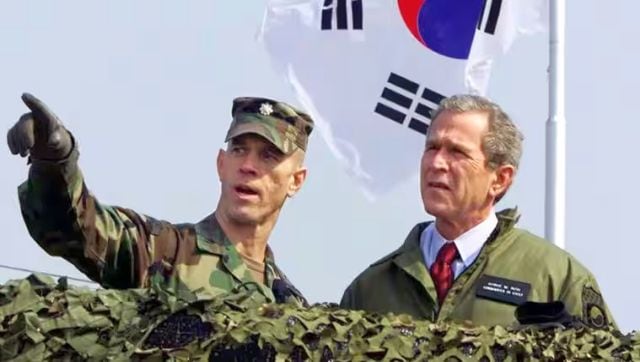 US president George W Bush looks out at North Korea from Observation Point Ouellette in the Demilitarized Zone, the tense military border between the two Koreas, in Panmunjom. File image/AP[/caption] After Kim Jong-un took power in North Korea, he travelled to Panmunjom and met front-line North Korean troops in March 2012, his first ever visit. In the same month, US president Barack Obama also made his first visit to the demilitarised zone and told the troops over there, “You guys are at freedom’s frontier.” [caption id=“attachment_12885762” align=“alignnone” width=“640”]
US president George W Bush looks out at North Korea from Observation Point Ouellette in the Demilitarized Zone, the tense military border between the two Koreas, in Panmunjom. File image/AP[/caption] After Kim Jong-un took power in North Korea, he travelled to Panmunjom and met front-line North Korean troops in March 2012, his first ever visit. In the same month, US president Barack Obama also made his first visit to the demilitarised zone and told the troops over there, “You guys are at freedom’s frontier.” [caption id=“attachment_12885762” align=“alignnone” width=“640”]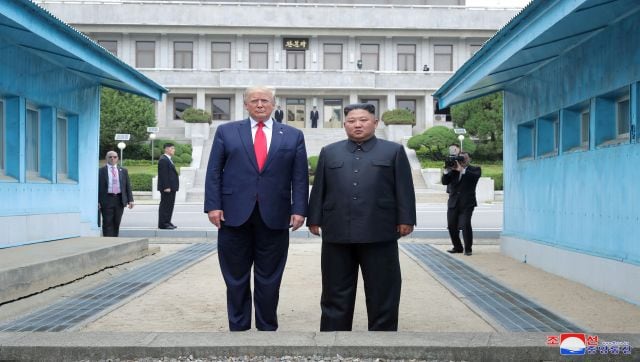 US president Donald Trump and North Korean leader Kim Jong Un pose at a military demarcation line at the demilitarised zone (DMZ) separating the two Koreas, in Panmunjom, South Korea in June 2019. File image/Reuters[/caption] In 2019, Donald Trump, the then American president, made history by becoming the first serving US leader to step foot in North Korea after crossing the demarcation line. In June of that year, Trump shook hands with North Korea’s Kim Jong-un and held a meeting with him. While Kim had said their meeting was a symbol of their “excellent” friendship, Trump had said it was a “great day for the world”. With inputs from agencies
US president Donald Trump and North Korean leader Kim Jong Un pose at a military demarcation line at the demilitarised zone (DMZ) separating the two Koreas, in Panmunjom, South Korea in June 2019. File image/Reuters[/caption] In 2019, Donald Trump, the then American president, made history by becoming the first serving US leader to step foot in North Korea after crossing the demarcation line. In June of that year, Trump shook hands with North Korea’s Kim Jong-un and held a meeting with him. While Kim had said their meeting was a symbol of their “excellent” friendship, Trump had said it was a “great day for the world”. With inputs from agencies
An American soldier has been detained by Pyongyang for crossing the heavily fortified demilitarised zone (DMZ) without permission. This 248-kilometre-long and four-kilometre-wide buffer zone was created in 1953 after the Korean War, separating the country into two – North and South Korea
Advertisement
End of Article


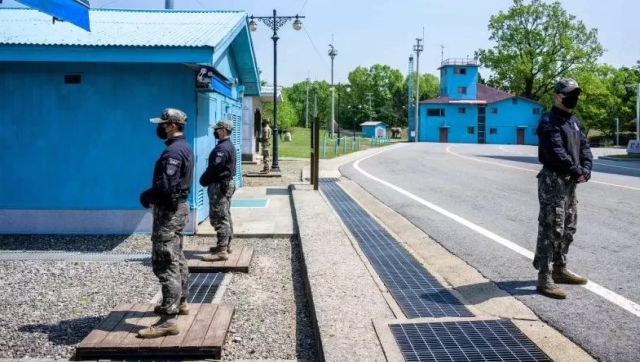)

)
)
)
)
)
)
)
)



